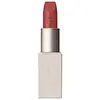Saie Lip Blur Soft-Matte Hydrating Lipstick with Hyaluronic Acid Versus Rose Inc Satin Lip Color Refillable Hydrating Lipstick
What's inside
What's inside
 Key Ingredients
Key Ingredients

 Benefits
Benefits

 Concerns
Concerns

 Ingredients Side-by-side
Ingredients Side-by-side

Octyldodecanol
EmollientEuphorbia Cerifera Wax
Copernicia Cerifera Wax
Ricinus Communis Seed Oil
MaskingHelianthus Annuus Seed Wax
Skin ConditioningHydrogenated Coco-Glycerides
EmollientJojoba Esters
EmollientHectorite
AbsorbentUndecane
EmollientOlea Europaea Oil Unsaponifiables
Skin ConditioningSilica
AbrasiveTridecane
PerfumingShorea Robusta Resin
TonicRhus Verniciflua Peel Cera
EmollientPolyglycerin-3
HumectantAcacia Decurrens Flower Cera
EmollientSodium Hyaluronate
HumectantCI 15985
Cosmetic ColorantCI 77891
Cosmetic ColorantCI 77491
Cosmetic ColorantCI 15850
Cosmetic ColorantCI 77492
Cosmetic ColorantCI 77499
Cosmetic ColorantOctyldodecanol, Euphorbia Cerifera Wax, Copernicia Cerifera Wax, Ricinus Communis Seed Oil, Helianthus Annuus Seed Wax, Hydrogenated Coco-Glycerides, Jojoba Esters, Hectorite, Undecane, Olea Europaea Oil Unsaponifiables, Silica, Tridecane, Shorea Robusta Resin, Rhus Verniciflua Peel Cera, Polyglycerin-3, Acacia Decurrens Flower Cera, Sodium Hyaluronate, CI 15985, CI 77891, CI 77491, CI 15850, CI 77492, CI 77499
Pentaerythrityl Tetraisostearate
EmollientCaprylic/Capric Triglyceride
MaskingRicinus Communis Seed Oil
MaskingBis-Diglyceryl Polyacyladipate-2
EmollientSynthetic Wax
AbrasiveEuphorbia Cerifera Wax
Hydrogenated Vegetable Oil
EmollientEthylene/Propylene Copolymer
AbrasiveIsopropyl Palmitate
EmollientSilica
AbrasiveSwertia Chirata Extract
HumectantBrassica Alba Sprout Extract
Skin ConditioningSqualane
EmollientSodium Hyaluronate
HumectantC13-15 Alkane
SolventHelianthus Annuus Seed Oil
EmollientHydrogenated Castor Oil
EmollientRosmarinus Officinalis Leaf Extract
AntimicrobialLecithin
Emollient1,2-Hexanediol
Skin ConditioningCaprylyl Glycol
EmollientPhenethyl Alcohol
MaskingCymbopogon Martini Herb Oil
PerfumingCoriandrum Sativum Fruit Oil
MaskingEthyl Vanillin
MaskingPelargonium Graveolens Oil
MaskingWater
Skin ConditioningGeraniol
PerfumingLinalool
PerfumingCitronellol
PerfumingCI 77891
Cosmetic ColorantIron Oxides
CI 15850
Cosmetic ColorantCI 45410
Cosmetic ColorantCI 19140
Cosmetic ColorantCI 42090
Cosmetic ColorantPentaerythrityl Tetraisostearate, Caprylic/Capric Triglyceride, Ricinus Communis Seed Oil, Bis-Diglyceryl Polyacyladipate-2, Synthetic Wax, Euphorbia Cerifera Wax, Hydrogenated Vegetable Oil, Ethylene/Propylene Copolymer, Isopropyl Palmitate, Silica, Swertia Chirata Extract, Brassica Alba Sprout Extract, Squalane, Sodium Hyaluronate, C13-15 Alkane, Helianthus Annuus Seed Oil, Hydrogenated Castor Oil, Rosmarinus Officinalis Leaf Extract, Lecithin, 1,2-Hexanediol, Caprylyl Glycol, Phenethyl Alcohol, Cymbopogon Martini Herb Oil, Coriandrum Sativum Fruit Oil, Ethyl Vanillin, Pelargonium Graveolens Oil, Water, Geraniol, Linalool, Citronellol, CI 77891, Iron Oxides, CI 15850, CI 45410, CI 19140, CI 42090
Alternatives
Ingredients Explained
These ingredients are found in both products.
Ingredients higher up in an ingredient list are typically present in a larger amount.
Ci 15850 is the pigment color red. It is an azo dye and created synthetically.
Azo dyes need to be thoroughly purified before use. This allows them to be more stable and longer-lasting.
This ingredient is common in foundations, lipsticks, and blushes. This color is described as brown/orangey red.
It has many secondary names such as Red 6 and Red 7. According to a manufacturer, Red 6 usually contains aluminum.
Learn more about CI 15850Ci 77891 is a white pigment from Titanium dioxide. It is naturally found in minerals such as rutile and ilmenite.
It's main function is to add a white color to cosmetics. It can also be mixed with other colors to create different shades.
Ci 77891 is commonly found in sunscreens due to its ability to block UV rays.
Learn more about CI 77891Ricinus Communis Seed Oil is the INCI name for castor oil.
Castor Oil helps moisturize the skin. It is rich in a fatty acid called ricinoleic acid. This fatty acid helps prevent moisture loss on the skin. This helps keep your skin soft and hydrated. Ricinoleic acid also has anti-inflammatory and pain reducing properties.
Besides hydrating the skin, castor oil is also used to hydrate hair. By keeping the hair shaft moisturized, breakage is decreased. More studies are needed to show castor oil's effective on stimulating hair growth.
Castor oil is created by cold-pressing castor seeds and then purifying the oil with heat. It was used in Ancient Egypt as fuel in lamps and to help treat eye irritation.
The term 'fragrance' is not regulated in many countries. In many cases, it is up to the brand to define this term. For instance, many brands choose to label themselves as "fragrance-free" because they are not using synthetic fragrances. However, their products may still contain ingredients such as essential oils that are considered a fragrance.
Learn more about Ricinus Communis Seed OilSilica, also known as silicon dioxide, is a naturally occurring mineral. It is used as a fine, spherical, and porous powder in cosmetics.
Though it has exfoliant properties, the function of silica varies depending on the product.
The unique structure of silica enhances the spreadability and adds smoothness, making it a great texture enhancer.
It is also used as an active carrier, emulsifier, and mattifier due to its ability to absorb excess oil.
In some products, tiny microneedles called spicules are made from silica or hydrolyzed sponge. When you rub them in, they lightly polish away dead skin layers and enhance the penetration of active ingredients.
Learn more about SilicaSodium Hyaluronate is hyaluronic acid's salt form. It is commonly derived from the sodium salt of hyaluronic acid.
Like hyaluronic acid, it is great at holding water and acts as a humectant. This makes it a great skin hydrating ingredient.
Sodium Hyaluronate is naturally occurring in our bodies and is mostly found in eye fluid and joints.
These are some other common types of Hyaluronic Acid:
Learn more about Sodium HyaluronateEuphorbia Cerifera wax comes from a shrub in Northern Mexico. It is used to stabilize formulations and has emollient properties.
Emollients form a thin layer on top of skin to prevent water from evaporating, keeping skin and lips hydrated.
According to a manufacturer, this wax can range from a yellow/brown color to translucent.
Learn more about Euphorbia Cerifera Wax